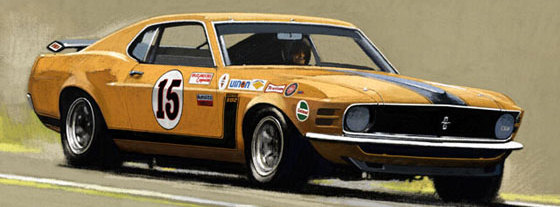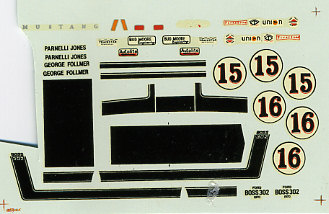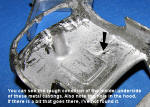
| KIT: | Scale Model Technical Services (SMTS) 1/43 Ford Boss 302 Trans Am |
| KIT #: | 1B |
| PRICE: | $51.00 |
| DECALS: | Two options |
| REVIEWER: | Scott Van Aken |
| NOTES: | Cast metal with rubber tires and vac windscreen |

| HISTORY |
Without a doubt, for many of us, the 'golden age' of auto racing was in the 1960s and into the early 1970s. This was a time when the sport was still a sport and not a business. Men raced because they loved it and others backed them for the very same reasons. Sure, there was some factory involvement, but nothing like the crass commercialism of today's automobile racing. True, the basics of the sport are still there, but much of the fun of racing seems to be gone.
I can recall seeing many famous racing teams arriving at the track with the car on a trailer behind a station wagon or pickup truck. No 18-wheelers with a name emblazoned across the side. These were the days when one could buy a ticket for $5 and a pit pass for another $5, giving the ordinary fan an opportunity to get right up next to the cars and perhaps have a chance to chat with a driver or owner. Now these men and their machines are behind heavy fences or walls and 'protected' against their fans by hangers-on and hired security goons.
Anyway, one of the premier US racing series' was the Trans Am championship. These were basically your 'pony cars' like the Mustang, Camaro, Challenger and Javelin. The rules were simple. It had to be a factory produced chassis and body with an engine no larger than 5 liters or 305 cubic inches. All the usual race stuff was in the cars like headers, stripped interiors, wide tires on custom racing wheels and the like. The head lights were blocked, but the brake lights had to work. Though about as far from streetable as you could get, it was still a car that you could go to the dealer and buy all the basics. Streetable versions like the Z-28 and Boss 302 and Firebird Trans Am were sold to those with the huge amount of money (at least $5000) to be able to buy one of these beasts.
Like nearly all racing series' the hey-day came and went. While it was reintroduced in later years, it wasn't the same as the cars were specialized racing cars that sorta looked like what people drove and the amount of money needed to field competitive cars was astronomical. But isn't that the way it always seems to be. Though not as successful as they'd have like to have been, the Ford team campaigned two cars during 1970, one for George Follmer and the other for Parnelli Jones. As in the previous years, it was the Penske racing operation and Mark Donahue, this year in an AMC Javelin, who won most of the events, though it wasn't from a lack of trying by the others in the series!
| THE KIT |
 I've
never seen an SMTS kit so had no idea what to expect when I blindly ordered this
one. Normally my passion in 1/43 is sports racers but when I saw that I could
get a Trans Am car, I decided to give it a shot. Besides, it was relatively
inexpensive (and believe me, $50 is pretty cheap for these kits).
I've
never seen an SMTS kit so had no idea what to expect when I blindly ordered this
one. Normally my passion in 1/43 is sports racers but when I saw that I could
get a Trans Am car, I decided to give it a shot. Besides, it was relatively
inexpensive (and believe me, $50 is pretty cheap for these kits).
When it arrived in the mails, I was somewhat taken back
by its weight (the website said nothing about this not being resin). So when
opening the box revealed a metal kit, I could understand the weight. The outside
of the main moldings is very good, but the inside is a disaster area of stubs,
large sections of thick, metal flash and ground away areas. Most of the metal
parts contain flash that will be time consuming to remove, but that is part and
parcel for kits like this. Conversely, the chromed parts (front grille/bumper,
rear bumper and door handles) are superbly done, flash and stub free and ready
to install. A small photo etch fret is included for headlight blanking plates,
windscreen wipers and a few other small bits. Vacuformed plastic is used for the
windscreen, rear window, and small rear quarter windows.

 The
instructions I received were for a Challenger and I've written for a
replacement. If it is typical, then the single folded sheet provides a short
history, parts listing and and a couple of generic paragraphs on how to
build these sorts of kits. The other half of the sheet is an exploded view of
the pieces.
The
instructions I received were for a Challenger and I've written for a
replacement. If it is typical, then the single folded sheet provides a short
history, parts listing and and a couple of generic paragraphs on how to
build these sorts of kits. The other half of the sheet is an exploded view of
the pieces.
My kit was also missing one of the axles and there is a hole in the hood as well. I'm not sure if something goes there or not as I couldn't see anything that might fit. The decal sheet provides markings for either the Follmer or Jones car. The sheet is well printed and should go on without any real trouble. I was hoping there would be an instrument panel decal included as the panel has no dial detail at all. No color information is provided for either the inside or the outside of the car, but I do know that these cars were a carmel orange color as I have photos around somewhere of them taken at the 1970 Road America event.
| CONCLUSIONS |
No one ever said that kits like this would be easy and I can foresee this one being a longer build than most. The good part of it is that there are kits around of these cars for the 1/43 enthusiast. I just wonder why all the good ones of these subjects are made outside the US?
As a note, a letter I sent to SMTS resulted in the new instructions and missing axle arriving within 10 days of my sending the letter. Now that is customer service!
March 2007
Review kit courtesy of me!
If you would like your product reviewed fairly and quickly by a site that has over 350,000 visitors a month, please contact me or see other details in the Note to Contributors.